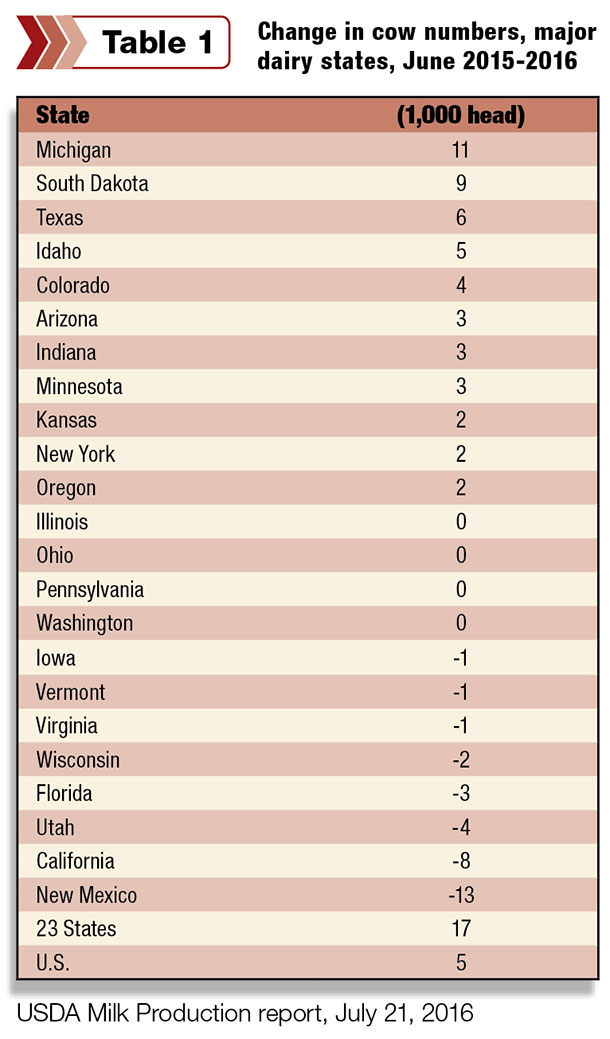USDA’s June milk estimates showed relatively strong production, but there’s still hope milk prices can stabilize and improve, according to Bob Cropp, professor emeritus at the University of Wisconsin – Madison.
First, a look at production numbers. Nationally, June 2016 milk production was estimated at 17.77 billion pounds, up 1.5 percent from June 2015 and the strongest monthly year-over-year gain since March.
Milk cow numbers were estimated at 9.328 million head, 5,000 head more than June 2015, and up 1,000 head from May 2016. Production per cow averaged 1,905 pounds for June, 27 pounds more than June 2015.
June 2016 milk production in the 23 major dairy states was estimated at 16.655 billion pounds, up 1.6 percent from June 2015. Cow numbers in those states were estimated at 8.647 million head, 17,000 head more than June 2015, and 3,000 more than May 2016.
Production per cow averaged 1,926 pounds for June, 26 pounds more than June 2015 and the highest production per cow for the month of June since the 23-state series began in 2003.
Regional, state production
Regional milk production patterns remained the same as the past few months, Cropp noted. Production was stronger in the Northeast and Midwest, and weaker but improved the West.
South Dakota again topped the list for largest year-over-year gain in milk production, at 6.6 percent, followed by Michigan, up 5.4 percent. New York, Texas, Wisconsin and Kansas also posted gains of at least 3.5 percent.
Milk production in Utah (-6.3 percent), Florida (-4.5 percent) and New Mexico (-3.5 percent) led the decliners, with Virginia and California also down from the year before. Most of those declines were due to lower cow numbers. New Mexico cow numbers were down 13,000 from the year before; California was down 8,000.
Year-over-year growth in cow numbers was largest in Michigan, South Dakota, Texas, Idaho and Colorado (Table 1).

Compared to May 2016, cow numbers were mostly unchanged, with only Texas, Minnesota, Michigan and South Dakota reporting gains. California, Florida, Utah and Wisconsin each saw June cow numbers drop from May.
Most of the national increase can be attributed to milk per cow, according to Mark Stephenson, director of dairy policy analysis at the University of Wisconsin-Madison.
Cows in New York and Wisconsin averaged 75 pounds more milk compared to the same month a year earlier, with South Dakota, Utah, Virginia and Florida down 30 to 40 pounds per cow compared to June 2015 (Table 2).

Although USDA projects 2016 milk production will rise about 1.8 percent from 2015, Cropp expects the increase to be closer to 1.6 percent.
“Much of the dairy country is currently experiencing some extreme temperatures, which could reduce milk per cow, especially if these temperatures persist through the rest of July and into August,” he said.
Price outlook
“The good news is milk prices bottomed out in May and are now improving,” Cropp said in his monthly outlook report.
The July Class III price will be about $15.35 per hundredweight (cwt), up from $13.22 per cwt in June and $12.76 per cwt in May. Class III futures are in the $16s for the remainder of the year.
The July Class IV price will be near $15.10 per cwt, up from $13.77 per cwt in June and $13.09 per cwt in May. Class IV futures reach $16 in September and stay there for the remainder of the year. However, it’s uncertain if prices can hold at those levels, Cropp warned.
Cropp forecasts the Class III price could average about $14.50 per cwt for the year, compared to $15.80 per cwt last year and $22.34 per cwt in 2014. He projects the Class IV price could average around $14.45 per cwt for the year, compared to $14.35 per cwt last year and $22.09 per cwt in 2014.
Surprisingly high dairy product prices have helped bolster farmer milk prices, but stocks are increasing and exports remain weak.
Stephenson has a similar price forecast, with full price recovery delayed by the weaker exports.
See Cropp/Stephenson’s monthly podcast.
“Whether dairy product prices increase in the months ahead will depend on continued strong sales and lower milk production than now forecasted,” Cropp said. “It doesn’t look like we can expect much improvement in exports to increase prices. It might take into the first quarter of 2017, but 2017 will have better prices than 2016.” PD

-
Dave Natzke
- Editor
- Progressive Dairyman
- Email Dave Natzke







